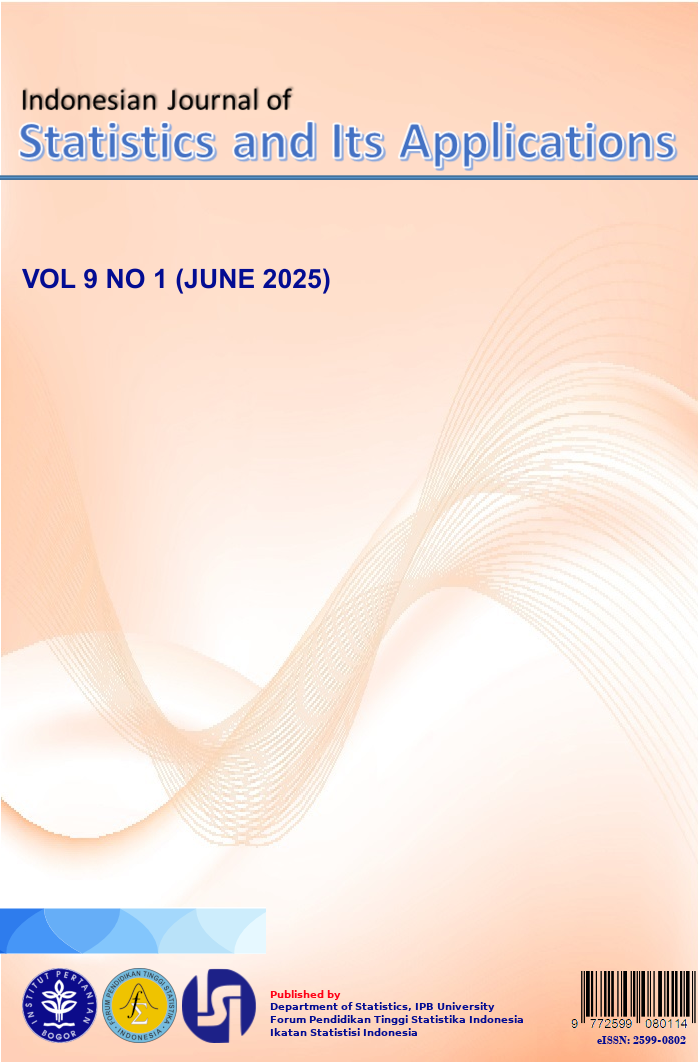K-Prototypes Algorithm for School Indexing in Report Card-Based Student Admissions Algoritma K-Prototypes untuk Indeks Sekolah pada Penerimaan Mahasiswa Baru Jalur Rapor
Main Article Content
Abstract
Institut Pertanian Bogor, also known as IPB University, is a state university that was ranked first as the best university in Indonesia by the Ministry of Research and Technology in 2020. It has three main channels in the new student admission selection system. The selection method is called “Seleksi Nasional Berdasarkan Prestasi”. “Seleksi Nasional Berdasarkan Prestasi” is one of the new student admission pathways at IPB University based on report cards without a test. The selection of new student admissions based on report cards requires creating a school index to assess the quality and commitment of each school by grouping schools among “Seleksi Nasional Berdasarkan Prestasi” applicants. One method that can be used is the K-Prototypes algorithm. K-Prototypes can be used to cluster large and mixed-type data (numeric and categorical) by combining distance measures from two non-hierarchical methods, namely the K-Means and K-Modes algorithms. Based on the analysis, the K-Prototypes algorithm yields three optimal clusters, each with distinct characteristics. Cluster 1 is the lowest cluster because it comprises schools with the lowest quality and commitment to new student admissions at IPB University, as indicated by the report card. Cluster 2 has a quality that is not superior to Cluster 3 but is higher than that of Cluster 1. Cluster 3 is the best cluster because it consists of schools that have high quality and commitment to new student admissions at IPB University through the report card route.
Downloads
Article Details
References
Aulia, F. (2022). Klasifikasi sekolah pada penerimaan mahasiswa baru jalur SNMPTN di IPB University menggunakan metode regresi logistik multinomial [Skripsi]. Bogor (ID): IPB University.
Bunkers, MJ. Miller, JR. DeGaetano, AT. (1996). Definition of climate region in the northern plains using an objective cluster modification technique. Journal of Climate, 9(1): 130-146.
Dewantari, NKM. (2021). Penggerombolan sekolah pada penerimaan mahasiswa baru jalur SNMPTN di IPB menggunakan metode two-step cluster [Skripsi]. Bogor (ID): IPB University.
Fadilah, ZR. Wijayanto, AW. Perbandingan metode klasterisasi data bertipe campuran: one-hot-encoding, gower distance, dan K-Prototypes berdasarkan akurasi (studi kasus: chronic kidney disease dataset). Journal of Applied Informatics and Computing, 7(1): 63-73.
Gan, G. MA, C. Wu, J. (2007). Data Clustering Theory, Algorithms, sand Applications. Virginia (US): American Statistical Association (ASA).
Ganmanah, M. Kudus, A. (2021). Penerapan algoritma K-Prototypes untuk pengelompokkan desa-desa di Provinsi Jawa Barat berdasarkan indikator indeks desa membangun tahun 2020. Prosiding Statistika, 7(2): 543-548. doi: http://dx.doi.org/10.29313/.v0i0.28974
Hair, JF. Black, WC. Babin, JB. Anderson, RE. (2010). Multivariate Data Analysis .7th ed. New Jersey (US): Pearson Prentice Hall.
Huang, Z. (1997). Clustering large data sets with mixed numerik and categorical values. Proceeding of the First Pacific Asia Knowladge Discovery and Data Mining Conference, 21–34.
Huang, Z. (1998). Extension to the K-Means algorithm for clustering large data sets with categorical values. Data Mining and Knowladge Discovery, 2(3): 283-304.
Kader, GD. Perry, M. (2007). Variability for categorical variables. Journal of Statistics Educations, 15(2): 1–16.
Kurniawan, E. (2016). Metode topsis untuk menentukan penerimaan mahasiswa baru pendidikan dokter di Universitas Muhammadiyah Purwokerto [Tesis]. Purwokerto (ID): Universitas Muhammadiyah Purwokerto.
Lin, HJ. Yang, FW. Kao, YT. (2005). An efficient GA-based clustering technique. Tamkang Journal of Science and Engineering, 8(2): 113-122.
Maulani. (2020). Perbandingan desa/kelurahan di Provinsi Banten berdasarkan indikator kemiskinan menggunakan algoritma k-prototypes [Tesis]. Bogor (ID): IPB University.
Munthe, AD. (2019). Penggerombolan desa/kelurahan di Provinsi Nusa Tenggara Timur menggunakan algoritma two-step cluster (TSC) dan algoritma k-prototypes [Tesis]. Bogor (ID): IPB University.
Munthe, AD. Sumertajaya, IM. Syafitri, UD. (2018). Penggerombolan desa/kelurahan berdasarkan indikator kemiskinan dengan menerapkan algoritma TSC dan k-prototypes. Indonesian Journal of Statistics and Its Applications, 2(2): 63-76.
Pasaribu, D. (2019). Segmentasi mahasiswa baru S1 IPB berdasarkan karakteristiknya menggunakan algoritme K-Prototypes [Skripsi]. Bogor (ID): Institut Pertanian Bogor.
Okada, T. (1999). Sum of squares decomposition for categorical data. Kwansei Gakuin Studies in Computer Science, 14: 1-6.
Salkind, NJ. (2007). Encyclopedia of Measurement and Statistics. California (US): SAGE Publications.
Sulastri, S. Usman, L. Syafitri, UD. (2021). K-Prototypes algorithm for clustering schools based on the student admission data in IPB University. Indonesian Journal of Statistics and Its Applications, 5(2): 228-242. doi: https://doi.org/10.29244/ijsa.v5i2p228-242
Wijayati, R. Saputro, DR. (2023). Clustering data campuran numerik dan kategorik menggunakan algoritme K-Prototypes. PRISMA, Prosiding Seminar Nasional Matematika 2023, 5(6): 702-706.

